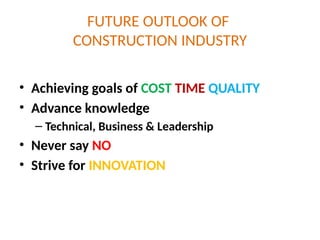work break down in construction projects LEC 2.pptx
- 1. LECTURE 2
- 2. CONSTRUCTION INDUSTRY IMPORTANCE • For any civil engineering project, generally, 85% to 95% costs always go to construction and design costs count from 0.5% to maximum of 15%. • It is said that construction supports 85 industries. For example, if a high rise building is built, one need cement, aggregates, sand, bricks, tiles, chips, glass, wood for doors and windows, steel bars, aluminum windows, electrical cables, switches, conduits, bulbs or tube lights, electric fans, air conditioners, furniture, sanitary fittings, marble tiles, water tabs, water pipes, sewerage pipes, distempers, paints, etc. and the list goes on. Once, the building is ready, it may be a house/hotel or office building, one needs furniture, refrigerator, washing machine, cooking range, computers, TV or other stuff in your kitchen or bed rooms.
- 4. CATEGORIES OF CONSTRUCTION PROJECTS • Why distinguished? – Funding ways – Technologies applications – Interaction (contract) of stakeholders • Client Consultant Constructor – Facilities usability
- 5. CATEGORIES OF CONSTRUCTION PROJECTS 1. RESIDENTIAL CONSTRUCTION • Housing/living/dwelling • It accounts for about 30 to 35% of construction expenditure in a year. It includes family homes, multi-unit town houses, high- rise apartments and houses. • Mostly privately funded • Designed by architects /individual for one home • Low technology usage involvement of small designers/contractors • E.g. Bharia Town, Eden housing authority, Defence housing authority (DHA)
- 6. CATEGORIES OF CONSTRUCTION PROJECTS 2. NON RESIDENTIAL CONSTRUCTION • It includes small retail stores, departmental stores, schools, colleges, universities, hospitals, commercial office towers, theaters, government buildings, recreation centers and warehouses. • Economically, this sector accounts for 35 to 40% of the construction market. • Privately/publically funded • Architects /General contractor • Technical complexity high in comparison with residential projects • E.g. UOL, Shukat Khanam, HyperStar,Emporium mall
- 7. CATEGORIES OF CONSTRUCTION PROJECTS 3. INFRASTRUCTURE AND HEAVY ENGINEERING CONSTRUCTION • Heavy engineering construction accounts for some 20 to 25% of the market. Examples are dams and tunnels, flood control structures, irrigation canals, bridges, railways, airports, highways, rapid transit systems, ports and harbor structures. • Capital intensive – Massive material quantities – Large fleet of machinaries/equipment • Specialized civil engineers/qualified contractor • Publically funded • Sensitive - Influence of governmental policy • Long duration • E.g. Kala Bagh Dam, Allama Iqbal Airport, Canal, Gawadar port
- 8. CATEGORIES OF CONSTRUCTION PROJECTS 4. INDUSTRIAL CONSTRUCTION • Industrial construction represents about 5 to 10% of the market. However, it has some of the largest projects and is dominated by largest engineering and construction firms. Petroleum refineries, petrochemical plants, nuclear power plants, steel mills, manufacturing plants etc. are examples of industrial construction projects. • Heavy investment and highly specialized • Largest engineering and contractors (Expertise) • Mostly publically funded • Chemical, electrical, mechanical, relevant discipline expertise • “Sub contractors - Labour intensive • E.g. Steel Mills, Heavy industries Taxila, Attock refinery, Pioneer cement, ICI paints, KANUPP
- 9. CATEGORIES OF CONSTRUCTION PROJECTS 5. SPECIAL PURPOSE PROJECTS • These include environmental works, emergencies, remedial works, installation and commissioning of equipment and complex key operations. • Highly specialized (few expertise) • Heavy investment (scope of work) • Technological complexities • Complex Interaction of stakeholders • E.g. Tower erection, repair of Minar-e-Pakistan, grid stations,
- 10. MAIN CAUSES OF PROJECT FAILURE • Commonly non achievement of Goals [Specified Cost and Time] • Survey 1990s: 351 major construction projects – 56% had cost overruns (totaling 20% cost) – 49% faced a time overruns from 1 to 157 months
- 11. MAIN CAUSES OF PROJECT FAILURE 1. Inadequate project formulation – Poor field investigation, – Inadequate project information – Bad cost estimates – Lack of expertise, – Inadequate project analysis – Poor investment decisions
- 12. MAIN CAUSES OF PROJECT FAILURE 2. Poor Planning for implementation – Inadequate time plan – Inadequate resources plan – Inadequate equipment supply plan – Inter-linking not anticipated – Poor organization – Poor cash flow planning
- 13. MAIN CAUSES OF PROJECT FAILURE 3. Lack of proper contract planning and management – Improper pre-contract actions – Poor post award contract management
- 14. MAIN CAUSES OF PROJECT FAILURE 4. Lack of project management during execution – Useless working – Delays – Changes in scope of work and location – Law and order – Unnatural calamities: Earthquake, floods etc. – Cost estimation failure
- 15. CONSTRUCTION MANAGEMENT • The study of construction can be structured into two general themes: 1. Construction technology 2. Construction management • Construction technology relates to the methods or techniques used to place the materials and elements of construction at the job site. The word technology can be broken into two sub-words i.e. technical from “techno” and logic from sequence or procedure – something is done first, another thing second, and so on until a result is achieved. • Construction management addresses how the resources available to the manager can be best applied. When speaking of resources for construction, we think of 4 Ms of construction: money, materials, manpower and machines. Management involves the timely and efficient application of the 4 Ms to construct a project.
- 16. STAKEHOLDER • CLIENT • CONSULTANT • CONTRACTOR
- 17. STAKEHOLDER STAKEHOLDER Responsibilities CLIENT Investor, decision maker CONSULTANT Interact with client and contractor CONTRACTOR Expert, Driver of construction vehicle
- 18. CONSTRUCTION INDUSTRY • Ofori (1990) defined the construction industry as “that sector of economy which plans, designs, constructs, modifies, maintains, repairs buildings of all kinds, civil engineering works, mechanical and electrical structures and other similar works”.
- 19. NATURE OF CONSTRUCTION INDUSTRY • Need of world inhabitants – Shelter – Access – Energy – Work space – Security • Complex role of Designers and Constructors
- 20. CHALLENGES OF CONSTRUCTION INDUSTRY • Rapidly Escalating Technology [1 of 7] Build the 3D vision – SKYDOME – MAKKAH TOWER – BURJ DUBAI
- 21. CHALLENGES OF CONSTRUCTION INDUSTRY • Lacking specialists [2 of 7] – No more Master Builder – CAD operator, planner [expert in work] – Today Project features • Location: UAE • Designed in: Italy • Construct by: US • Manpower: Pakistan
- 22. CHALLENGES OF CONSTRUCTION INDUSTRY • Computational Tools Focus on Optimization [3 of 7] – Usage of software packages in all phases of project. – Designing, estimation, scheduling, planning, monitoring, construction – Building information modeling (BIM)
- 23. CHALLENGES OF CONSTRUCTION INDUSTRY • Strict Regulations Evolve Attentive Environment [4 of 7] – Laws, regulations, permits etc. – Environmental safety – Fire safety – Differentiate Building codes and Building regulations
- 24. CHALLENGES OF CONSTRUCTION INDUSTRY • Construction is a Fragmented Industry [5 of 7] APPROVAL • NHA, Environment, Transportation • Infrastructure, Fire, Police FUND • Business agencies • Banks DESIGNN • Architects, • Structure engineers • Graphic designers • Transportation Engineers CONSTRUCTION • Construction Managers • Contractors • Labour • Material • Testing • Surveyors
- 25. CHALLENGES OF CONSTRUCTION INDUSTRY • Construction Project Success is all about Team Work [6 of 7] – People VS Machine – Communication – Leadership
- 26. CHALLENGES OF CONSTRUCTION INDUSTRY • Construction Industry Provides Indicator of Economic Health [7 of 7] – Dependent industries – More employments – Economy health indicator – World dependent economies
- 27. FUTURE OUTLOOK OF CONSTRUCTION INDUSTRY • Achieving goals of COST TIME QUALITY • Advance knowledge – Technical, Business & Leadership • Never say NO • Strive for INNOVATION
- 28. Thank You


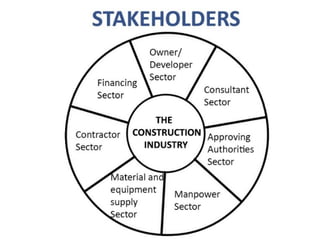
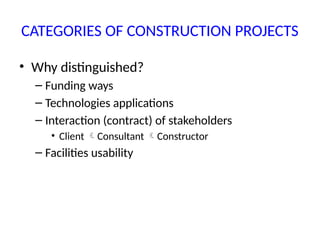


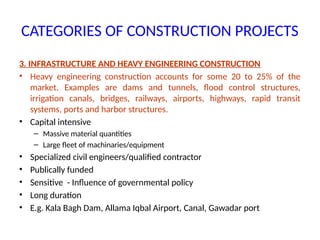

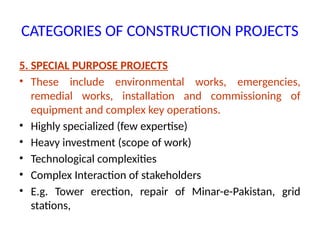
![MAIN CAUSES OF PROJECT FAILURE
• Commonly non achievement of Goals
[Specified Cost and Time]
• Survey 1990s: 351 major construction projects
– 56% had cost overruns (totaling 20% cost)
– 49% faced a time overruns from 1 to 157 months](https://image.slidesharecdn.com/lecture2-250403172432-5751d394/85/work-break-down-in-construction-projects-LEC-2-pptx-10-320.jpg)

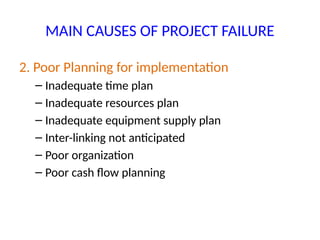


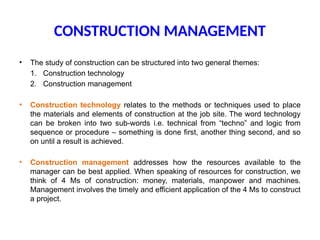
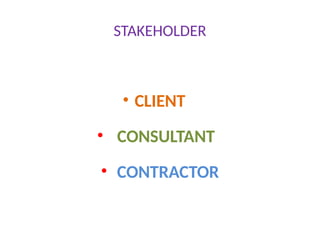



![CHALLENGES OF CONSTRUCTION INDUSTRY
• Rapidly Escalating Technology [1 of 7]
Build the 3D vision
– SKYDOME
– MAKKAH TOWER
– BURJ DUBAI](https://image.slidesharecdn.com/lecture2-250403172432-5751d394/85/work-break-down-in-construction-projects-LEC-2-pptx-20-320.jpg)
![CHALLENGES OF CONSTRUCTION INDUSTRY
• Lacking specialists [2 of 7]
– No more Master Builder
– CAD operator, planner [expert in work]
– Today Project features
• Location: UAE
• Designed in: Italy
• Construct by: US
• Manpower: Pakistan](https://image.slidesharecdn.com/lecture2-250403172432-5751d394/85/work-break-down-in-construction-projects-LEC-2-pptx-21-320.jpg)
![CHALLENGES OF CONSTRUCTION INDUSTRY
• Computational Tools Focus on Optimization [3
of 7]
– Usage of software packages in all phases of
project.
– Designing, estimation, scheduling, planning,
monitoring, construction
– Building information modeling (BIM)](https://image.slidesharecdn.com/lecture2-250403172432-5751d394/85/work-break-down-in-construction-projects-LEC-2-pptx-22-320.jpg)
![CHALLENGES OF CONSTRUCTION INDUSTRY
• Strict Regulations Evolve Attentive
Environment [4 of 7]
– Laws, regulations, permits etc.
– Environmental safety
– Fire safety
– Differentiate Building codes and Building
regulations](https://image.slidesharecdn.com/lecture2-250403172432-5751d394/85/work-break-down-in-construction-projects-LEC-2-pptx-23-320.jpg)
![CHALLENGES OF CONSTRUCTION INDUSTRY
• Construction is a Fragmented Industry [5 of 7]
APPROVAL
• NHA,
Environment,
Transportation
• Infrastructure,
Fire, Police
FUND
• Business
agencies
• Banks
DESIGNN
• Architects,
• Structure
engineers
• Graphic
designers
• Transportation
Engineers
CONSTRUCTION
• Construction
Managers
• Contractors
• Labour
• Material
• Testing
• Surveyors](https://image.slidesharecdn.com/lecture2-250403172432-5751d394/85/work-break-down-in-construction-projects-LEC-2-pptx-24-320.jpg)
![CHALLENGES OF CONSTRUCTION INDUSTRY
• Construction Project Success is all about Team
Work [6 of 7]
– People VS Machine
– Communication
– Leadership](https://image.slidesharecdn.com/lecture2-250403172432-5751d394/85/work-break-down-in-construction-projects-LEC-2-pptx-25-320.jpg)
![CHALLENGES OF CONSTRUCTION INDUSTRY
• Construction Industry Provides Indicator of
Economic Health [7 of 7]
– Dependent industries
– More employments
– Economy health indicator
– World dependent economies](https://image.slidesharecdn.com/lecture2-250403172432-5751d394/85/work-break-down-in-construction-projects-LEC-2-pptx-26-320.jpg)
